Chinese Premier arrives in Australia as Anthony Albanese plays host to the communist superpower’s second in command for four days
Chinese Prime Minister Li Qiang has arrived in Australia for a four-day visit led by Anthony Albanese.
It is the first visit to Australia by a Chinese prime minister in seven years and heralds a thawing of recently frozen relations between Australia and the communist superpower.
The prime minister heads the State Council and is second in the seven-member ruling Politburo. Only President Xi Jinping, as head of the Chinese Community Party, surpasses him.
He was met at Adelaide airport by Foreign Minister Penny Wong and SA Prime Minister Peter Malinauskas at around 6pm on Saturday and will later meet Anthony Albanese and address Parliament in Canberra.
In recent months, the Prime Minister has attended the G20, the World Economic Forum and a trilateral summit with Japan and South Korea. Previous Prime Minister Li Keqiang visited Australia in 2017.
An official visit at this level requires the utmost in diplomacy. Formally, it is a repeat of the visit that Prime Minister Anthony Albanese made to China at the end of last year.
Chinese Premier Li Qiang arrived in Adelaide on Saturday evening (pictured) and was greeted by Penny Wong and SA Prime Minister Peter Malinauskas
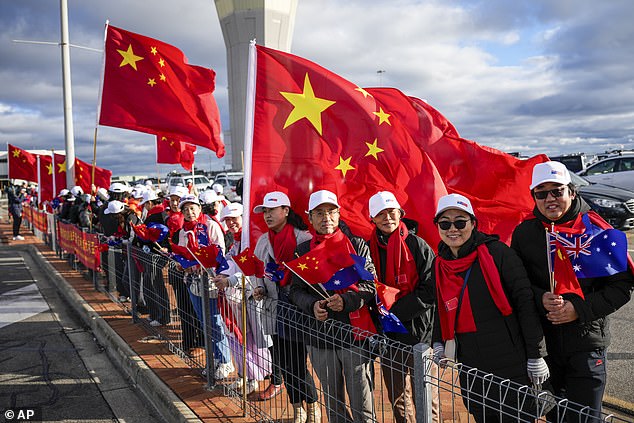
Crowds of supporters showed up at the airport, waving Australian and Chinese flags
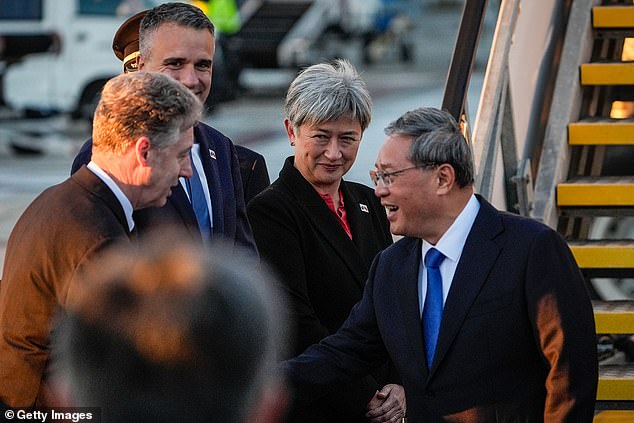
The Chinese Prime Minister, second in command after Xi Jinping, visits Anthony Albanese last year
What will the Prime Minister do?
In Canberra the emphasis will be on set pieces befitting the visit of a leader of a major world power (although I suspect nothing we do will top Indian Prime Minister Narendra Modi hosting Albanians for a pre-cricket lap of honor in a golden chariot).
There will be a full ceremonial welcome, including a military display and a visit to Governor General David Hurley. This is the protocol and symbolism that accompanies every official visit.
On the political front, the Prime Minister will co-chair the ninth annual China-Australia leaders’ meeting. Xi addressed parliament in 2014 (followed the next day by Modi – echoing the momentous occasion in 2003 when US President George W. Bush and Chinese President Hu Jintao gave speeches within a day of each other).
Xi has visited every Australian state – he joked he should “get a certificate for that” after his 2014 visit to Tasmania.
Li will spend time in Adelaide (to visit the pandas and have lunch with relieved wine exporters) and Perth (for trade promotion and a visit to the Chinese community) before continuing to Malaysia.
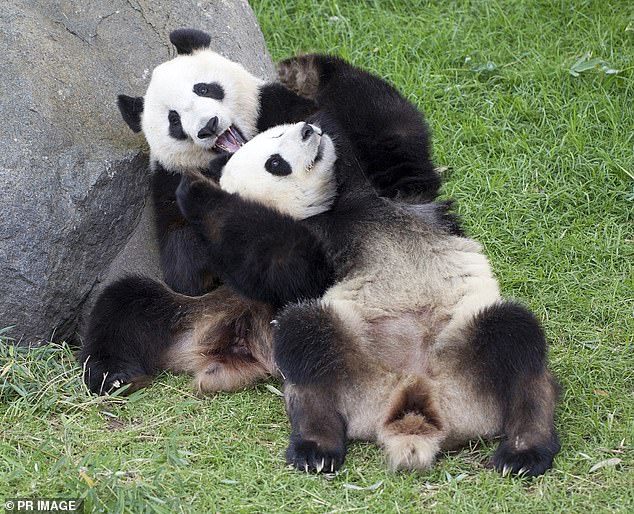
Prime Minister Li will visit the giant pandas at the Adelaide Zoo (pictured) as part of his visit Down Under
Just as we are used to our Prime Minister taking business delegations along on his travels, China sees the visit as an opportunity to promote business ties and investment.
The Prime Minister will visit a lithium refinery in Kwinana (a joint venture with China’s Tianqi Lithium), along with a Fortescue plant. He will join business leaders in an Australia-China CEO roundtable hosted by the Business Council of Australia.
It reminds us that, like Australia, China’s leaders have an all-consuming focus on improving economic growth.
Former diplomat Jocelyn Chey notes that given Li’s background in promoting entrepreneurial and commercial development, Li is likely to take a keen interest in the economic potential of greater interaction in industry and trade.
Will there be any major announcements?
Essentially, the work is done in advance to make the visit possible.
The Australian and Chinese foreign ministers met in Canberra in March, the defense ministers met in Singapore earlier this month and Trade Minister Don Farrell has been busy discussing trade restrictions, with recent announcements on barley and wine.
Lobster is virtually the last remaining industry to face trade barriers.
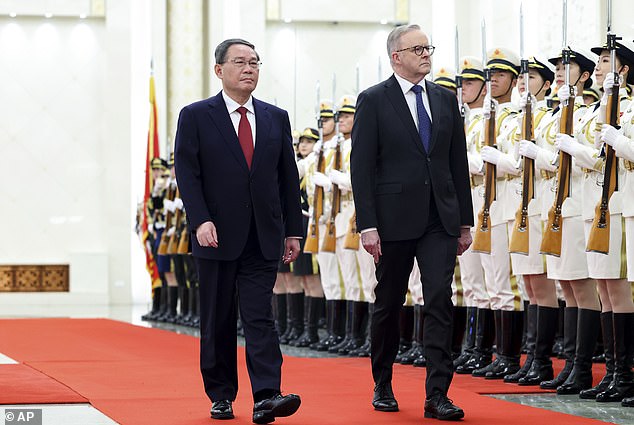
Prime Minister Anthony Albanese will host Chinese Premier Li Qiang for part of his trip (pictured shows the pair meeting in China late last year)
The Albanian government has largely achieved its goal of ‘stabilizing’ relations. This visit is more about exploring what else is possible in the relationship.
Many will listen carefully to Li’s messages, which may be subtle. In an opaque political system, top-level statements will be parsed for hints about policy and direction.
The Chinese people are one of the main target groups for these signals: for example, lower-level officials, import companies, those planning vacations and parents deciding where their children will study.
Australia will be hoping for a continuation of reports that the country is back on the ‘friendly’ country list. The sense that Australia was ‘not so friendly, even hostile’ negatively influenced many small decisions made by a range of actors. It may be mentioned that Li’s daughter studied in Australia.
Persistent areas of disagreement
While those involved in the protocol will always want to reduce controversy, it is inevitable that the Chinese Prime Minister will face fierce media questions and likely demonstrations, for example by Uyghur, Falun Gong and Hong Kong protesters.
Albanians have vowed to raise issues during Li’s visit, in line with his oft-repeated: “We will cooperate where we can, disagree where we must and advance our national interest.”
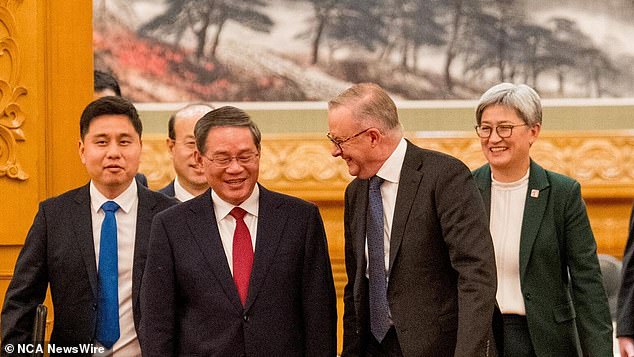
Albanese became the first Australian prime minister to visit China since 2016 after flying to Beijing in November. He is pictured with Chinese Premier Li Qiang
This includes human rights issues, including the death sentence handed down earlier this year against Australian citizen Yang Hengjun. Albanians are likely to renew their concerns over Chinese actions against Australian personnel in the Yellow Sea that are enforcing U.N. sanctions against North Korea, among other long-standing areas of disagreement between the two countries.
Diplomacy in action
Above all, the Prime Minister’s visit will demonstrate that China and Australia are able to maintain a ‘normal’ diplomatic relationship after the years of ‘deep freeze’.
It will illustrate the value of diplomacy – not as an end in itself – but as a way to communicate: to express your point of view, to resolve disagreements and to try to exert influence.
There are great differences in the relationship between China and Australia. The UTS:ACRI/BIDA survey published this week shows just how deep Australians’ distrust of China still runs. A state visit cannot put this on paper.
But compared to the years when Australia had no way to communicate or influence with China, this is a better situation – and more in line with other countries.
As Australia seeks to manage relations with China – consistent with its national interest and support for global rules – diplomacy provides tools to maximize the positives and limit the negatives of a perennially important but difficult relationship.
